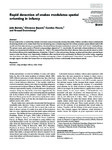Rapid detection of snakes modulates spatial orienting in infancy
| dc.contributor.author | Bertels, J | |
| dc.contributor.author | Bayard, C | |
| dc.contributor.author | Floccia, Caroline | |
| dc.contributor.author | Destrebecqz, A | |
| dc.date.accessioned | 2017-09-18T13:16:02Z | |
| dc.date.available | 2017-09-18T13:16:02Z | |
| dc.date.issued | 2017-02-22 | |
| dc.identifier.issn | 0165-0254 | |
| dc.identifier.issn | 1464-0651 | |
| dc.identifier.other | 0 | |
| dc.identifier.uri | http://hdl.handle.net/10026.1/9953 | |
| dc.description.abstract |
Recent evidence for an evolved fear module in the brain comes from studies showing that adults, children and infants detect evolutionarily threatening stimuli such as snakes faster than non-threatening ones. A decisive argument for a threat detection system efficient early in life would come from data showing, in young infants, a functional threat-detection mechanism in terms of “what” and “where” visual pathways. The present study used a variant of Posner’s cuing paradigm, adapted to 7–11-month-olds. On each trial, a threat-irrelevant or a threat-relevant cue was presented (a flower or a snake, i.e., “what”). We measured how fast infants detected these cues and the extent to which they further influenced the spatial allocation of attention (“where”). In line with previous findings, we observed that infants oriented faster towards snake than flower cues. Importantly, a facilitation effect was found at the cued location for flowers but not for snakes, suggesting that these latter cues elicit a broadening of attention and arguing in favour of sophisticated “what–where” connections. These results strongly support the claim that humans have an early propensity to detect evolutionarily threat-relevant stimuli. | |
| dc.format.extent | 0165025417693955-0165025417693955 | |
| dc.language | en | |
| dc.language.iso | en | |
| dc.publisher | SAGE Publications | |
| dc.subject | attention | |
| dc.subject | cuing paradigm | |
| dc.subject | infancy | |
| dc.subject | snake | |
| dc.subject | threat | |
| dc.title | Rapid detection of snakes modulates spatial orienting in infancy | |
| dc.type | journal-article | |
| dc.type | article | |
| plymouth.author-url | https://www.webofscience.com/api/gateway?GWVersion=2&SrcApp=PARTNER_APP&SrcAuth=LinksAMR&KeyUT=WOS:000434391100001&DestLinkType=FullRecord&DestApp=ALL_WOS&UsrCustomerID=11bb513d99f797142bcfeffcc58ea008 | |
| plymouth.issue | 4 | |
| plymouth.volume | 0 | |
| plymouth.publisher-url | https://doi.org/10.1177/0165025417693955 | |
| plymouth.publication-status | Published | |
| plymouth.journal | International Journal of Behavioral Development | |
| dc.identifier.doi | 10.1177/0165025417693955 | |
| plymouth.organisational-group | /Plymouth | |
| plymouth.organisational-group | /Plymouth/Faculty of Health | |
| plymouth.organisational-group | /Plymouth/Faculty of Health/School of Psychology | |
| plymouth.organisational-group | /Plymouth/REF 2021 Researchers by UoA | |
| plymouth.organisational-group | /Plymouth/REF 2021 Researchers by UoA/UoA04 Psychology, Psychiatry and Neuroscience | |
| plymouth.organisational-group | /Plymouth/REF 2021 Researchers by UoA/UoA04 Psychology, Psychiatry and Neuroscience/UoA04 REF peer reviewers | |
| plymouth.organisational-group | /Plymouth/Research Groups | |
| plymouth.organisational-group | /Plymouth/Research Groups/Centre for Brain, Cognition and Behaviour (CBCB) | |
| plymouth.organisational-group | /Plymouth/Research Groups/Centre for Brain, Cognition and Behaviour (CBCB)/Cognition | |
| plymouth.organisational-group | /Plymouth/Research Groups/Plymouth Institute of Health and Care Research (PIHR) | |
| plymouth.organisational-group | /Plymouth/Users by role | |
| plymouth.organisational-group | /Plymouth/Users by role/Academics | |
| dcterms.dateAccepted | 2017-01-10 | |
| dc.identifier.eissn | 1464-0651 | |
| dc.rights.embargoperiod | No embargo | |
| rioxxterms.versionofrecord | 10.1177/0165025417693955 | |
| rioxxterms.licenseref.uri | http://www.rioxx.net/licenses/all-rights-reserved | |
| rioxxterms.licenseref.startdate | 2017-02-22 | |
| rioxxterms.type | Journal Article/Review |


